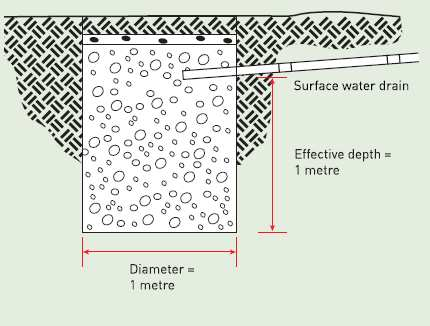Trench Soakaway

Description
<p style="margin-right:0cm;margin-left:0cm;font-size:15px;font-family:Calibri, sans-serif;margin-top:0cm;margin-bottom:15pt;line-height:107%;background:#F7F7F8;border:none;padding:0cm;"><span>Ashghal, the Public Works Authority in Qatar, is responsible for designing and implementing stormwater management systems, including soakaways. Soakaways are drainage systems that allow surface water to infiltrate into the ground, reducing the risk of flooding and water pollution. Here is a summary of stormwater soakaway design calculation based on Ashghal guidelines:</span></p>
<ol style="list-style-type:decimal;margin-left:8px;">
<li><span>Site investigation: Conduct a thorough site investigation to gather data on soil type, infiltration rates, groundwater levels, and nearby structures or utilities. This information will help to determine the feasibility of a soakaway system and inform the design process.</span></li>
<li><span>Rainfall estimation: Use local rainfall data to estimate the rainfall intensity for the design storm event (e.g., a 1 in 100-year storm). This will help determine the volume of water the soakaway must be able to handle.</span></li>
<li><span>Catchment area calculation: Calculate the catchment area contributing to the soakaway, considering factors such as roof area, paved surfaces, and any other impermeable surfaces. The catchment area will help determine the volume of runoff generated during the design storm event.</span></li>
<li><span>Infiltration rate calculation: Determine the infiltration rate of the soil using field tests, such as double-ring infiltrometer tests or falling head permeability tests. The infiltration rate is crucial to understanding how quickly the soil can absorb the stormwater.</span></li>
<li><span>Storage volume calculation: Calculate the required storage volume for the soakaway by multiplying the catchment area by the rainfall depth during the design storm event, and then dividing by the infiltration rate. This will give the required storage volume to handle the design storm event.</span></li>
<li><span>Soakaway sizing: Size the soakaway based on the required storage volume, considering factors such as available space, excavation depth, and required setback distances from nearby structures or utilities. Common soakaway designs include trenches, pits, and modular systems made from various materials like concrete, plastic, or stone.</span></li>
<li><span>Safety factors and maintenance: Apply appropriate safety factors and design considerations to ensure the soakaway will function effectively over its intended lifespan. Plan for regular inspections and maintenance to prevent blockages, ensure performance, and extend the service life of the system.</span></li>
</ol>
<p><span>By following these steps and adhering to Ashghal guidelines, an effective stormwater soakaway design can be developed that manages runoff, reduces the risk of flooding, and protects the environment.</span></p>
<p style="margin-right:0cm;margin-left:0cm;font-size:15px;font-family:Calibri, sans-serif;margin-top:0cm;margin-bottom:15pt;line-height:107%;background:#F7F7F8;border:none;padding:0cm;"><span>A trench soakaway, also known as an infiltration trench or French drain, is a linear structure filled with permeable material that helps manage stormwater by allowing it to infiltrate into the ground. To design a trench soakaway, follow these steps:</span></p>
<ol style="list-style-type:decimal;margin-left:8px;">
<li><span>Site investigation: Conduct a site investigation to gather information on soil type, infiltration rates, groundwater levels, and nearby structures or utilities. Perform percolation tests or infiltration tests, such as a double-ring infiltrometer test, to determine the soil's infiltration rate.</span></li>
<li><span>Catchment area calculation: Calculate the catchment area contributing to the soakaway, considering factors such as roof area, paved surfaces, and any other impermeable surfaces. The catchment area will help determine the volume of runoff generated during the design storm event.</span></li>
<li><span>Rainfall estimation: Use local rainfall data to estimate the rainfall intensity for the design storm event (e.g., a 1 in 100-year storm). This will help determine the volume of water the soakaway must be able to handle.</span></li>
<li><span>Runoff calculation: Calculate the runoff generated during the design storm event by multiplying the catchment area by the rainfall depth and the runoff coefficient (C). The runoff coefficient represents the fraction of rainfall that becomes runoff and varies based on the type of surface.</span></li>
<li><span>Storage volume calculation: Calculate the required storage volume for the soakaway by dividing the runoff volume by the infiltration rate. This will give the required storage volume to handle the design storm event.</span></li>
<li><span>Trench sizing: Size the trench based on the required storage volume, considering factors such as available space, excavation depth, and required setback distances from nearby structures or utilities. The dimensions of the trench (length, width, and depth) should be determined based on the storage volume, the infiltration rate, and the porosity of the fill material. Keep in mind that a longer, narrower trench will have more contact area with the surrounding soil and potentially better infiltration performance.</span></li>
<li><span>Material selection: Choose appropriate materials for the trench, including the permeable fill material (e.g., clean crushed stone, gravel), geotextile fabric (to prevent soil migration into the trench), and, if necessary, a perforated pipe to help distribute water evenly along the trench.</span></li>
<li><span>Construction details: Specify the construction details for the trench soakaway, including excavation, installation of geotextile fabric, placement of fill material, and, if applicable, installation of the perforated pipe.</span></li>
<li><span>Maintenance and inspection: Plan for regular inspections and maintenance to ensure the trench soakaway continues to function effectively. This includes checking for sediment buildup, blockages, or other issues that may affect performance.</span></li>
</ol>
<p><span>By following these steps and adhering to local guidelines and regulations, you can design an effective trench soakaway that manages stormwater runoff and reduces the risk of flooding and water pollution.</span></p>
<p style="margin-right:0cm;margin-left:0cm;font-size:15px;font-family:Calibri, sans-serif;margin-top:0cm;margin-bottom:8pt;line-height:107%;"> </p>
<br />Calculation Preview
Full download access to any calculation is available to users with a paid or awarded subscription (XLC Pro).
Subscriptions are free to contributors to the site, alternatively they can be purchased.
Click here for information on subscriptions.
Comments: 1
×
johndoyle-admin
3 years ago
A nice debut calculation! I have awarded a three month XLC Pro subscription by way of thanks.


